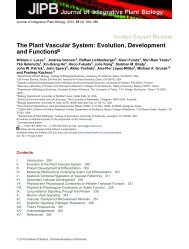Zygomorphy and heterandry in Solanum in a phylogenetic context
Zygomorphy and heterandry in Solanum in a phylogenetic context
Zygomorphy and heterandry in Solanum in a phylogenetic context
Create successful ePaper yourself
Turn your PDF publications into a flip-book with our unique Google optimized e-Paper software.
3. <strong>Solanum</strong> sect. Nycterium. The genus Nycterium Venten. was orig<strong>in</strong>ally created to<br />
encompass several <strong>Solanum</strong> species with heterantherous flowers. Included here were the<br />
type species N. cordifolium Venten., now known as S. vespertilio Ait., <strong>and</strong> several species<br />
now removed to <strong>Solanum</strong> sect. Androceras. Demoted to sectional rank by Walpers<br />
(1844), the traditional circumscription of <strong>Solanum</strong> sect. Nycterium (Venten.) Walp.<br />
<strong>in</strong>cludes heterantherous taxa from both Mexico (S. tridynamum <strong>and</strong> S. azureum) <strong>and</strong> the<br />
Canary Isl<strong>and</strong>s (S. lidii <strong>and</strong> S. vespertilio; Whalen, 1984). Dunal (1852) also <strong>in</strong>cluded the<br />
heterantherous African species S. coagulans (as S. dubium) <strong>in</strong> section Nycterium until it<br />
was removed to <strong>Solanum</strong> sect. Monodolichopus by Bitter (1923). Nee (1999), deal<strong>in</strong>g<br />
ma<strong>in</strong>ly with the New World <strong>Solanum</strong> species, considered the heterantherous Mexican <strong>and</strong><br />
Canary Isl<strong>and</strong> species to be closely related, but he <strong>in</strong>cluded the American<br />
S. elaeagnifolium <strong>and</strong> S. h<strong>in</strong>dsianum, both isantherous species or nearly so, <strong>in</strong> the same<br />
group. Some authors have <strong>in</strong>cluded S. pubescens Willd. of India <strong>and</strong> S. somalense Franch.<br />
of East Africa <strong>in</strong> this section, although these species were excluded from it <strong>in</strong> Whalen’s<br />
treatment (Whalen, 1984). The seed surface SEM studies of Lester et al. (1999) support a<br />
close relationship between S. tridynamum, S. lidii <strong>and</strong> S. vespertilio, but the seed surface<br />
characters of S. pubescens <strong>and</strong> S. somalense were more similar to species outside section<br />
Nycterium (see below). Whalen (1984) furthermore cast doubt on the monophyly of<br />
section Nycterium as circumscribed to <strong>in</strong>clude only the Mexican <strong>and</strong> Canary Isl<strong>and</strong>s<br />
species, po<strong>in</strong>t<strong>in</strong>g out differences <strong>in</strong> floral morphology between the two groups <strong>in</strong> spite of<br />
their shared heteranthery.<br />
Indeed, floral morphology differs considerably between the Mexican <strong>and</strong> Canary<br />
Isl<strong>and</strong> heterantherous taxa. In the Macaronesian species <strong>Solanum</strong> lidii <strong>and</strong> S. vespertilio,<br />
the flowers are four- to five-merous with strongly zygomorphic corollas. Of the four or<br />
five anthers, three to four are relatively short <strong>and</strong> straight <strong>and</strong> one long <strong>and</strong> curved; all the<br />
filaments are nearly of equal lengths (Fig. 3G, H). The style is also long <strong>and</strong> curved <strong>and</strong><br />
roughly the same length as the longest anther. Enantiostyly has been reported for<br />
S. vespertilio (G. Anderson, pers. commun.), but this character may be variable among<br />
<strong>in</strong>dividuals <strong>and</strong> populations. The plants are weakly <strong>and</strong>romonoecious <strong>and</strong> self-compatible.<br />
The fruits of the two species are fleshy berries not completely covered by accrescent<br />
fruit<strong>in</strong>g calyces.<br />
In contrast, plants of the Mexican species <strong>Solanum</strong> tridynamum bear two dist<strong>in</strong>ctly<br />
different types of flowers. Both types are five-merous <strong>and</strong> corollas are act<strong>in</strong>omorphic or<br />
weakly zygomorphic. In stam<strong>in</strong>ate flowers, the gynoecia are reduced <strong>and</strong> nonfunctional,<br />
with rudimentary styles. The two uppermost anthers are short <strong>and</strong> the three lowermost<br />
anthers are very long <strong>and</strong> curved; all filaments are roughly equal <strong>in</strong> length (Fig. 3K). In<br />
this strongly <strong>and</strong>romonoecious species, the basalmost is the only perfect flower on each<br />
<strong>in</strong>florescence. The five anthers are equal <strong>and</strong> relatively short <strong>in</strong> these flowers <strong>and</strong> the<br />
curved style is long <strong>and</strong> exserted from the r<strong>in</strong>g of stamens (Fig. 3J). The fruit<strong>in</strong>g calyx is<br />
strongly accrescent <strong>and</strong> completely covers the fruit. The fruit type is unusual <strong>in</strong> <strong>Solanum</strong>:<br />
it is erect, dry, <strong>and</strong> circumsessile or irregularly dehiscent, form<strong>in</strong>g a splash-cup or censertype<br />
of fruit <strong>in</strong> which seeds are dispersed by w<strong>in</strong>d or ra<strong>in</strong>, as opposed to the fleshy<br />
animal-dispersed berries common <strong>in</strong> most solanums (Lester <strong>and</strong> Symon, 1989).<br />
Greenhouse crosses showed S. tridynamum to be self-compatible (L. Bohs, unpubl. data).<br />
Other Heterantherous <strong>Solanum</strong>s<br />
In addition to the taxa described above, there are other examples of <strong>Solanum</strong><br />
species with unequal stamens, but lack<strong>in</strong>g the highly modified flowers seen <strong>in</strong> the focal<br />
groups. In most of these cases one stamen is longer than the other four, either due to an<br />
enlarged filament, an enlarged anther, or both. This morphology is seen <strong>in</strong> <strong>Solanum</strong><br />
species <strong>in</strong> several unrelated sections <strong>and</strong> clades, such as sections Aculeigerum Seithe<br />
(S. alternatop<strong>in</strong>natum Steud., S. glaucescens Zucc., S. bicorne, S. wendl<strong>and</strong>ii; Fig. 2B),<br />
Gonatotrichum Bitter (S. turneroides), <strong>and</strong> the Dulcamaroid clade sensu Bohs (2005)<br />
(S. ipomoeoides, S. pensile Sendtn.; Knapp, 2001, 2002a). This morphology seems to be<br />
constant with<strong>in</strong> a species. Two species of section Gem<strong>in</strong>ata (G. Don) Walp.<br />
204
















